Volvo have officially unveiled the Volvo EX30 for the Indian market, slated for launch soon. This is not only the most affordable EV Volvo has ever produced globally but also one of the most strategically important cars for the brand in India. By positioning the EX30 below the EX40, Volvo is making a decisive play for younger, urban luxury buyers who want sustainability and sophistication without stretching into the premium mid-size SUV bracket.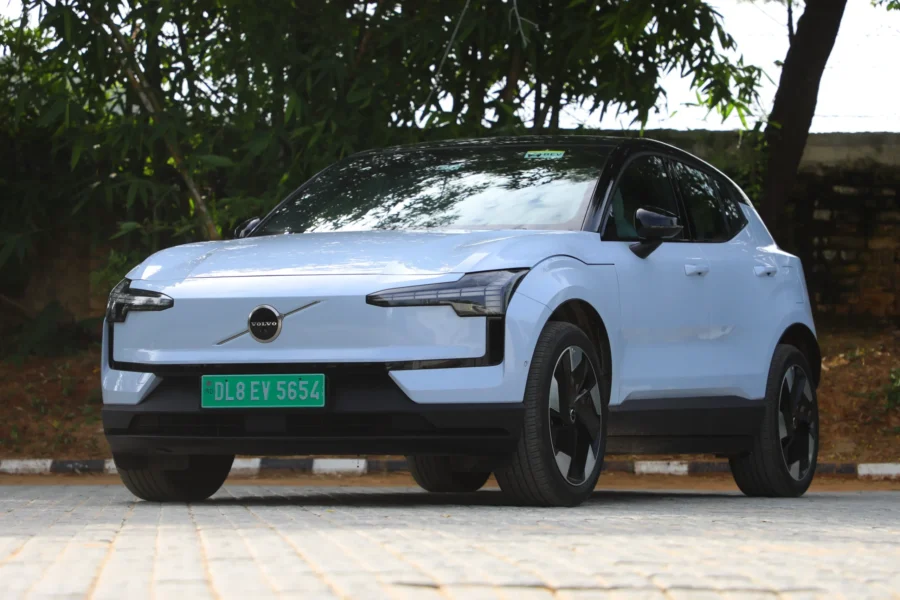
But in a world of EVs that fight for attention with size, screens, and speed, could being too understated cost it the game? Or is this precisely the kind of calm luxury the market has been waiting for? That is the big question surrounding the EX30. If the bet pays off, the Volvo EX30 could become the defining entry point for luxury EV ownership in India.
Volvo EX30 – Exterior Design
At first glance, the Volvo EX30 immediately stands out. It takes design cues from the brands larger EVs namely the EX40 and EX90. The signature Thor’s Hammer LED DRLs are slimmer, the grille is closed off for aerodynamic efficiency, and the rear design is futuristic yet familiar with split vertical taillamps. The EX30 is offered with five different colour options namely, “Crystal White”, “Onyx Black”, “Cloud Blue”, “Vapour Grey” and “Sand Dune”.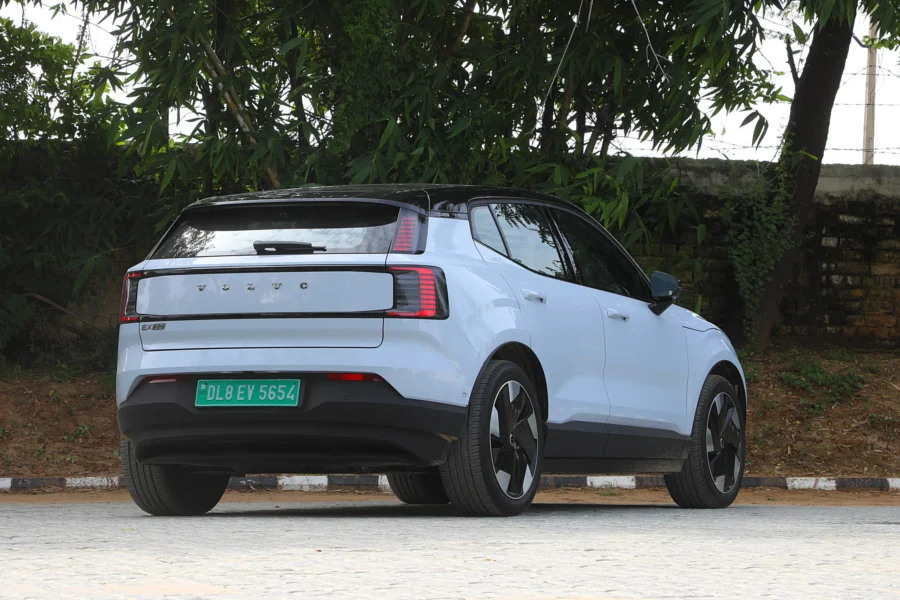
Dimensionally, it’s smaller than most traditional luxury SUVs but it doesn’t look underwhelming in presence. Instead, the EX30’s stance and large wheel arches give it an almost muscular appearance. You get large 19 inch wheels which have been aero optimized for better efficiency. The Volvo EX30 completely eliminates the use of a traditional key and instead uses an NFC card, which locks and unlocks the car by tapping the B-pillar.
Volvo EX30 – Interior Design
Step inside, and the Volvo EX30 doubles down on minimalism. The interior uses recycled and renewable materials, from upcycled denim jeans to flax-based composites. The dashboard is flanked by a single 12.3-inch portrait touchscreen running Google’s built-in ecosystem. Physical buttons are few, and almost all functions from climate to drive modes run through the digital interface present on the touchscreen.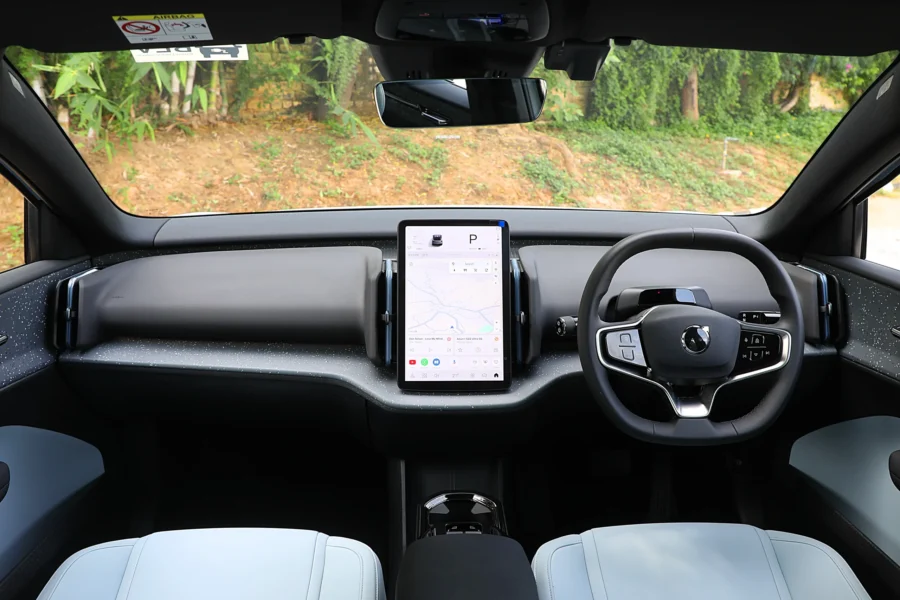
The Harman Kardon soundbar audio system is a highlight. A smart, space-saving design that completely eliminates speakers placed in the door-pads or pillars. There are few clever storage solutions add that touch of Scandinavian quirkiness. For any Indian customer, a car is only as good as its rear seat comfort, and this is where the dealbreaker lies. The rear seats feel tight and cramped, and can barely seat two adults, let alone three. The reason for the cramped 2nd row is the placement of the battery pack which eats up into the cabin space resulting in a knees-up seating position.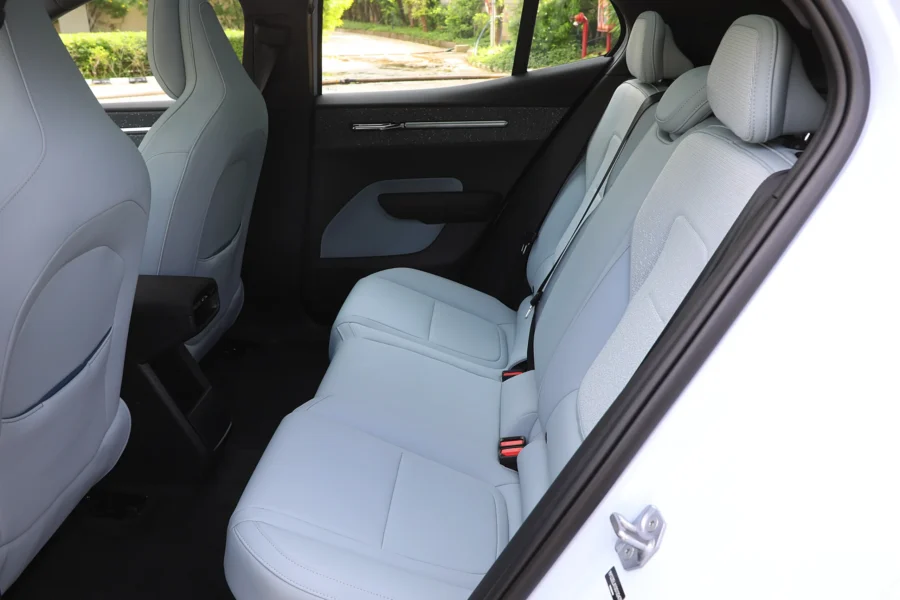
The addition of a fixed panoramic sunroof does give the cabin some sense of space but even that cannot mask the shortcomings of the rear seat. To put things in perspective, rear seat comfort is such a priority in this segment that BMW sells the iX1 exclusively in long-wheelbase guise.
Other standard features include 2 USB type-C Rear, 12V Socket in the boot, 5G Capability, Digital Audio Broadcasting (DAB), Apple CarPlay, Inductive Charging for Smartphone, Volvo Assistance ECALL/BCALL and powered tailgate.
Volvo EX30 – Safety Features
Volvo is known globally for its safety and has earned that reputation in India through its existing line-up. With the Volvo EX30, the brand brings a wide range of active safety systems to a more compact EV. Standard features include hill start assist, adaptive cruise control, lane keeping aid, blind spot monitoring, and traffic jam assist, while features like a 360-degree camera, driver alert, rear cross-traffic alert with autobrake, and intersection autobrake are a much welcome addition to the segment.
In terms of passive protection, the EX30 is equipped with seven airbags across the cabin along with features such as post-impact braking and a passenger airbag cut-off switch. While this is in line with expectations for a premium EV, it does highlight Volvo’s consistent approach of offering a full suite of occupant protection features.
Volvo EX30 – Battery Capacity and Range
The Volvo EX30 comes equipped with a 69 kWh battery pack that uses NMC (Nickel Manganese Cobalt) cell chemistry, known for its high energy density and long life cycles. On the WLTP cycle, it delivers a claimed range of 480 km on a single charge, putting it on par with larger rivals in its class. Charging options include an 11 kW AC charger that takes the battery from zero to fully-charged in around seven hours, ideal for overnight charging. There is also an option for DC fast charging that can charge the battery from 10–80 percent in just 25 minutes by using a 150 kW DC fast charger.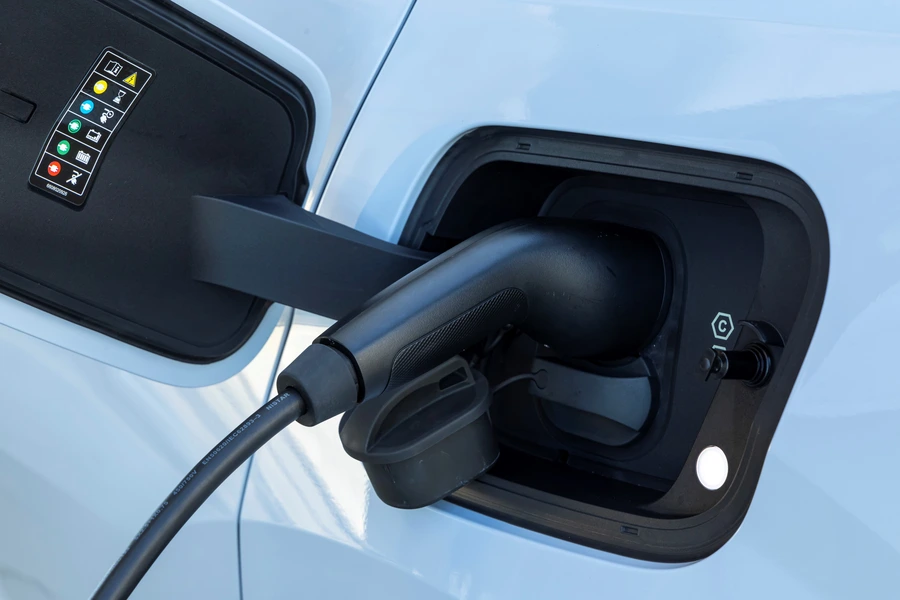
Volvo EX30 – Drive and Performance
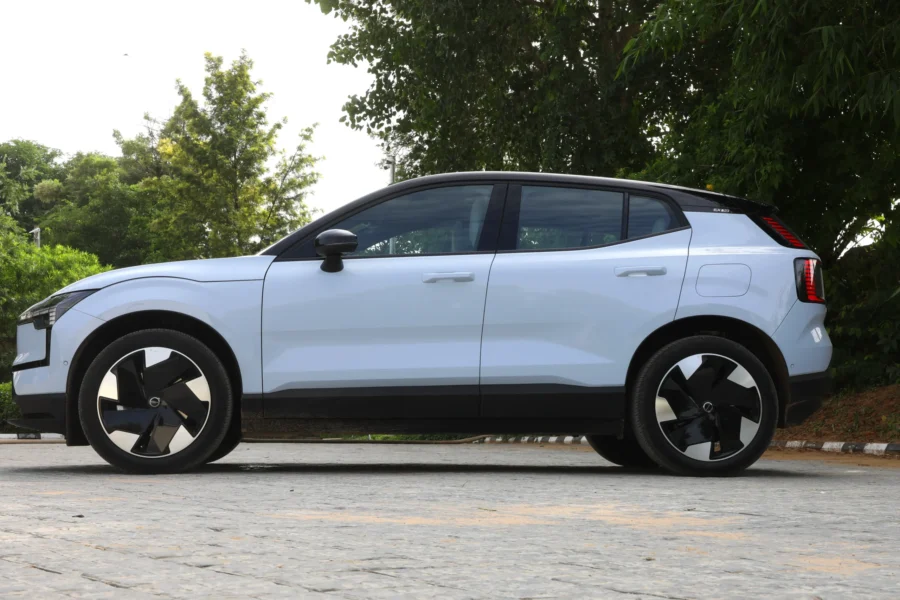
Volvo EX30 – Dynamics and Handling
Surprisingly, the EX30 doesn’t get adjustable regenerative braking and instead relies on its one-pedal drive system for energy recovery. Inside, cabin refinement is excellent, with insulation that keeps wind, tyre, and road noise at bay, creating a calm and comfortable atmosphere.
The suspension, paired with 19-inch wheels, is tuned on the firmer side. At low speeds, surface imperfections and potholes are felt clearly, making the ride somewhat taut, though not uncomfortable. As expected with stiffer setups, the overall ride quality improves noticeably as speeds rise. In straight-line driving, the EX30 feels extremely secure and composed, masking its pace with a planted stance.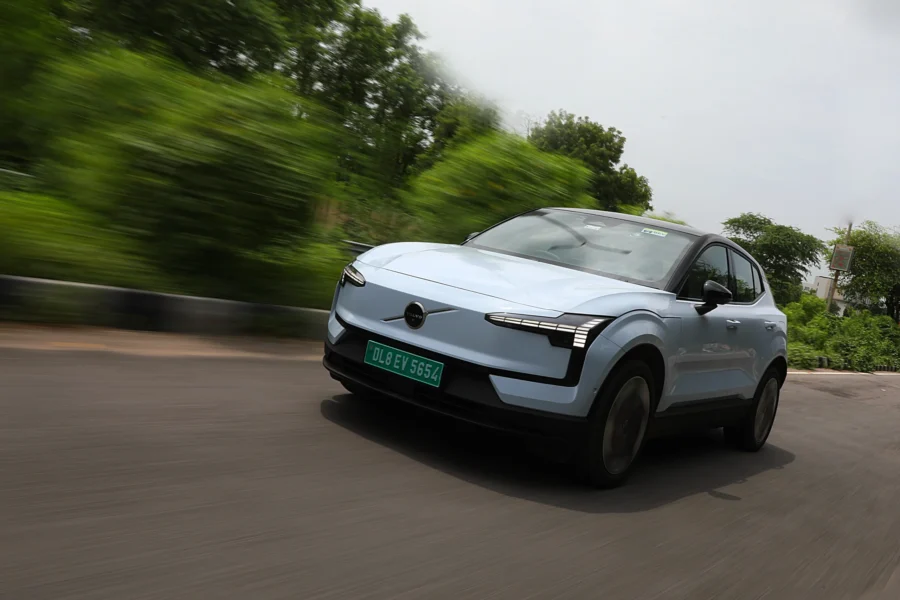
Road undulations are handled confidently, while body roll through corners is well-contained. Even when pushed hard into bends, the SUV stays balanced, absorbing mid-corner bumps without losing stability. Its low centre of gravity and firmer suspension tuning contribute to this poise. The electric steering system complements the package. It remains light and effortless in city traffic, becoming firmer at highway speeds to boost confidence. While it feels direct and reassuring, enthusiasts may find steering feedback a little muted.
Volvo EX30 – Market Positioning and Rivals
The Volvo EX30 occupies a unique space in the Indian luxury EV landscape, as it has no direct rivals in its exact segment. Positioned below the EX40 in Volvo’s own line-up which by itself takes on the BMW iX1 LWB and Mercedes EQA The EX30 is aimed at buyers seeking a more compact, accessible entry point into premium EV ownership.
Instead of competing head-on with German luxury SUVs, the EX30 will face challenges from models like the Hyundai Ioniq 5 and BYD Seallion 7, which offers similar range and battery capacity in a larger, more flamboyant package. To an extent, even Indian contenders such as the Mahindra XEV 9e fall into the contention, given the comparable specifications in battery architecture, range, features, and even safety.
Volvo EX30 – Verdict
The Volvo EX30 is the brands most ambitious launches in our market blending safety, sustainability, and minimalist design into Volvo’s most accessible EV yet. Its understated design and compact size set it apart, but with limited rear seat space and missing features, will Indian buyers embrace this quiet form of luxury—or look elsewhere for something louder?

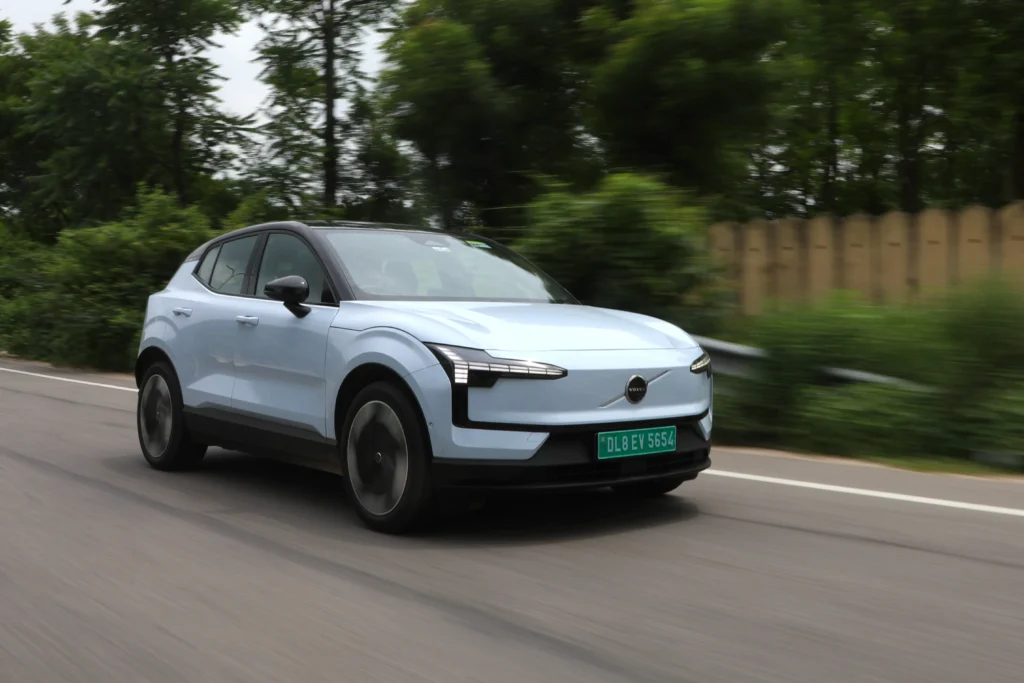
Pingback: Volvo EX30 vs BMW iX1 LWB - Features, Range, Tech and Price Compared - Shutterdrives